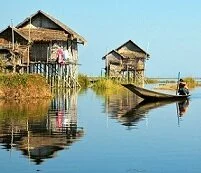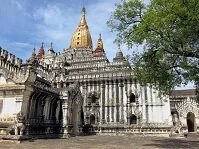Architecture of Myanmar

Houses on Lake Inle
Myanmar's architecture begins with the Bagan Empire, who took power in the 800s, but didn't blossom until they took over the Mon Empire to their south and imported their artisans. This led to the growth of Buddhism and the city of Bagan, from which nearly all traditional Myanmar architecture has evolved.
This city contains thousands of temples; however most of these temples were originally built as palaces for the kings. This led to an odd architecture which required that a building could be used as a palace, then after the king's death as a Buddhist temple. Nearly all of these palace-temples were built with brick and plaster and many remain standing today, although many are slowly collapsing.

Bagan
From the 800s until the 1200s Bagan was the center of the country in numerous fields, including architecture and all of the country's greatest monuments, both past and present are in the city. This includes the "library," (mid-1000s) which became a model for most latter buildings, and the stupas (funerary monuments) here, which altered the traditional stupa style in the region and includes the Ananda Temple (1090). In the late 1200s the city of Bagan was abandoned due to the country being overrun by the Mongols; leaving the city in ruins, but its influence continued on in other buildings, although few great structures were erected from the late 1200s.